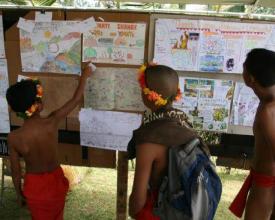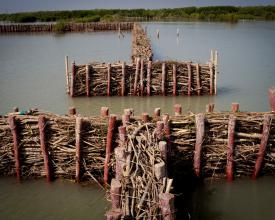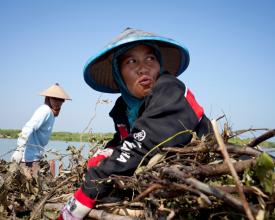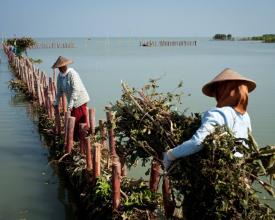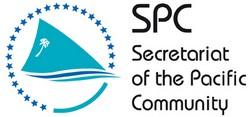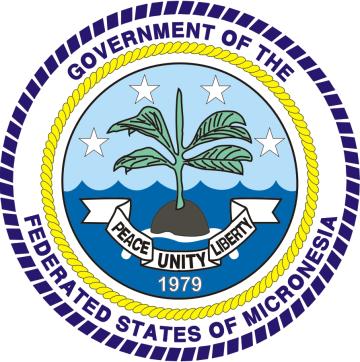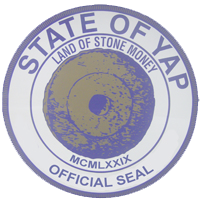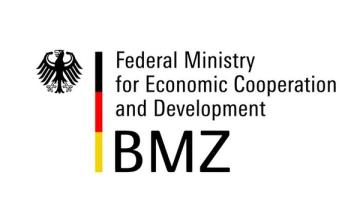
Approche écosystémique communautaire de la gestion des pêches (CEAFM)
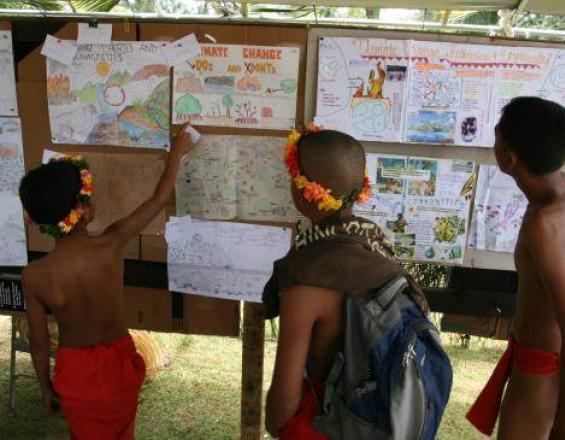
Le CEAFM s'attaque au problème du déclin des populations de poissons et de crustacés et aux impacts potentiels du changement climatique dans trois communautés sélectionnées dans l'État de Yap, FSM. Il s'agit d'une combinaison de trois perspectives différentes : la gestion des pêches, la gestion des écosystèmes et la gestion communautaire. Il s'agit d'une approche plus large de la gestion des pêcheries en tant que composante de l'écosystème marin.
Contexte
Défis à relever
Emplacement
Traiter
Résumé du processus
- Manifestation d'intérêt de la part de la communauté : Les communautés intéressées prennent contact avec leurs autorités municipales respectives pour mettre en place un projet CEAFM.
- Consultation initiale de la communauté et des chefs traditionnels de la communauté : L'équipe du projet rencontre les chefs traditionnels des communautés pour obtenir leur soutien au projet. Cette réunion permet aux chefs de la communauté de comprendre le programme et ses avantages à long terme.
- Mise en place du groupe de travail et des rôles du projet, y compris des parties prenantes importantes.
- Consultations et ateliers communautaires avec les groupes d'acteurs locaux concernés.
- Rédaction du plan de gestion de la pêche communautaire (voir bloc de construction 1). Une fois que la communauté aura approuvé le plan de gestion, celui-ci sera finalisé et soumis à l'approbation des chefs de la communauté et de l'équipe de projet.
- Approbation et mise en œuvre du plan de gestion communautaire (voir bloc 2 comme action de mise en œuvre possible).
- Suivi et révision : L'équipe de projet doit développer un processus de révision pour contrôler les activités du plan.
Blocs de construction
Plans de gestion communautaire
Les communautés analysent leurs pratiques de pêche et élaborent des plans communautaires visant à introduire des actions et des mesures de conservation appropriées. Ces plans sont soutenus par des programmes de sensibilisation et des conseils techniques. La stratégie repose sur trois principes : une participation maximale, la motivation plutôt que l'éducation et un processus fondé sur la demande. Les communautés doivent être convaincues qu'elles sont les premières responsables de la gestion de leur propre environnement marin, et non le gouvernement.
Facteurs favorables
- Simplifier le processus
- Respecter les coutumes et les protocoles locaux
- Motiver les gens
- Utiliser les connaissances traditionnelles
- Utiliser la science pour soutenir les objectifs de la communauté
- Adopter une approche de précaution
- Proposer des alternatives à la surexploitation des ressources
Leçon apprise
Cependant, les connaissances locales ont souvent été sous-estimées ; la plupart des communautés ont une conscience aiguë de leur environnement marin et s'en préoccupent. Ces points de vue doivent être pris en compte lors de l'élaboration des projets de gestion. Le succès des consultations communautaires dépend des animateurs. Ceux-ci doivent être dotés des compétences appropriées, telles que les compétences culturelles, traditionnelles, l'assurance, la capacité à encourager les individus à donner leur avis et la capacité à écouter plutôt qu'à enseigner. Les animateurs ne doivent jamais dominer les discussions ou exprimer leurs opinions - la neutralité est d'une importance capitale. Le matériel et les programmes de sensibilisation doivent tenir compte du public cible, de la manière dont ils sont diffusés et de l'identité des destinataires du message. Les messages sont parfois défensifs lorsqu'ils interprètent la situation locale. La communauté est propriétaire ou assume le contrôle de la zone gérée ou de la pêcherie.
Dispositifs de concentration de poissons (DCP)
Les DCP attirent les poissons pélagiques vers une certaine zone au large et facilitent donc la pêche au large, tout en réduisant la pression de la pêche sur les zones côtières telles que les récifs coralliens et en fournissant des moyens de subsistance alternatifs à la communauté locale. Sa mise en œuvre comprend les activités suivantes : - Formation de la communauté sur la construction, la gestion, le déploiement, l'entretien et les méthodes de pêche des DCP ; - Suivi continu des DCP et collecte de données pour évaluer les avantages sociaux et économiques des DCP ; - Stockage de matériel pour la réparation, l'entretien et les nouveaux déploiements des DCP.
Facteurs favorables
- Le plan communautaire de gestion de la pêche côtière doit être approuvé par la communauté concernée et par toutes les parties prenantes avant toute discussion sur les DCP.
- Les DCP ne sont qu'une option parmi d'autres en matière d'actions de gestion et doivent être communiqués à la communauté en tant que tels.
- Le déploiement des DCP doit toujours être associé à un programme de contrôle et d'évaluation afin de pouvoir ajuster et suivre le processus de mise en œuvre du projet.
Leçon apprise
Il est souvent difficile d'établir un lien suffisant entre le déploiement et l'évaluation des DCP et les programmes de suivi en cours, par exemple ceux des ONG de protection de la nature concernant les impacts sur les AMP existantes. Ce lien est pourtant essentiel pour évaluer les impacts et les changements attendus dans l'utilisation et la gestion des ressources côtières.
Renforcement des capacités des parties prenantes
La CPS propose un certain nombre de programmes régionaux et locaux de formation et de renforcement des capacités à l'intention des fonctionnaires du gouvernement national et des États, ainsi que des représentants des communautés. Ces programmes enseignent la gestion et des compétences spécifiques à tous les niveaux d'expertise. Ce processus contribue à la durabilité de la CEAFM.
Facteurs favorables
- Évaluer la volonté des homologues politiques d'accepter un soutien "extérieur" et leur capacité à mettre en œuvre durablement et à suivre le savoir-faire acquis au cours de la formation.
Leçon apprise
Il est très souvent difficile de garantir que les agents formés restent effectivement à leur poste pendant une période suffisante pour pouvoir réellement mettre en œuvre les compétences acquises au cours des formations. C'est pourquoi il est conseillé d'inclure une approche plus systémique qui comprend, par exemple, le renforcement des capacités institutionnelles au sein de l'agence concernée.
Impacts
L'analyse des données issues du programme de suivi des DCP à Yap permet de conclure que :
- Les DCP améliorent l'efficacité des pêcheurs, en termes d'augmentation des taux de capture ;
- Les DCP encouragent le changement de comportement des ménages, en détournant l'activité de pêche de la côte et en modifiant la consommation et la vente de poissons de récifs au profit des poissons pélagiques qui sont typiquement associés aux DCP ; et
- Le coût financier lié à l'acquisition et à l'installation des DCP est largement compensé par la valeur additionnelle des captures générées.
